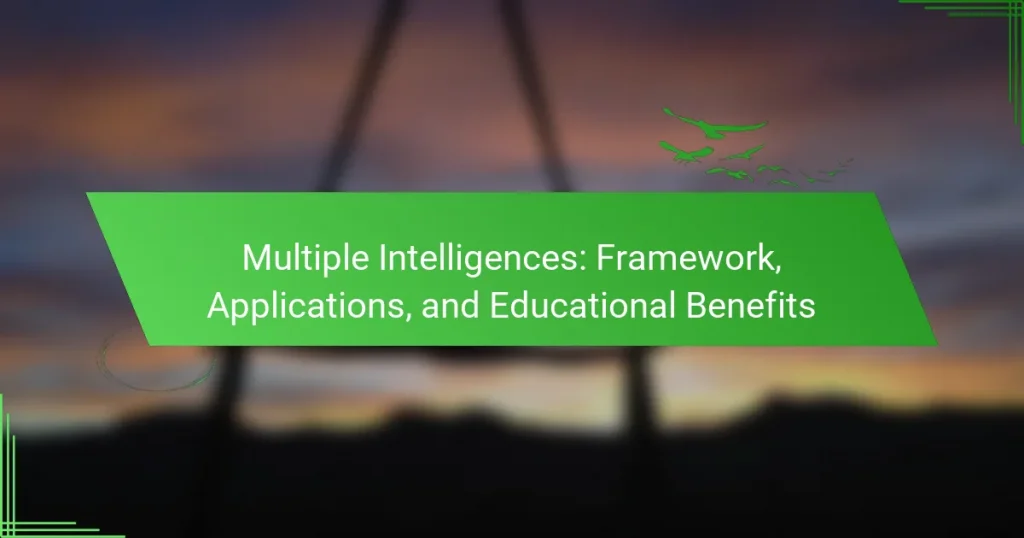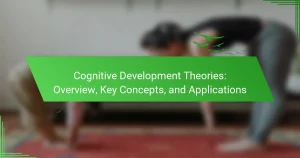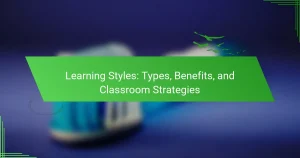Understanding Multiple Intelligences can significantly enhance educational outcomes by personalizing learning experiences. This framework identifies eight distinct types of intelligence that influence how individuals learn. The article explores effective applications in education, the benefits of tailored teaching strategies, and future trends shaping this approach. It also addresses challenges educators face in implementing these strategies to maximize student engagement and performance.
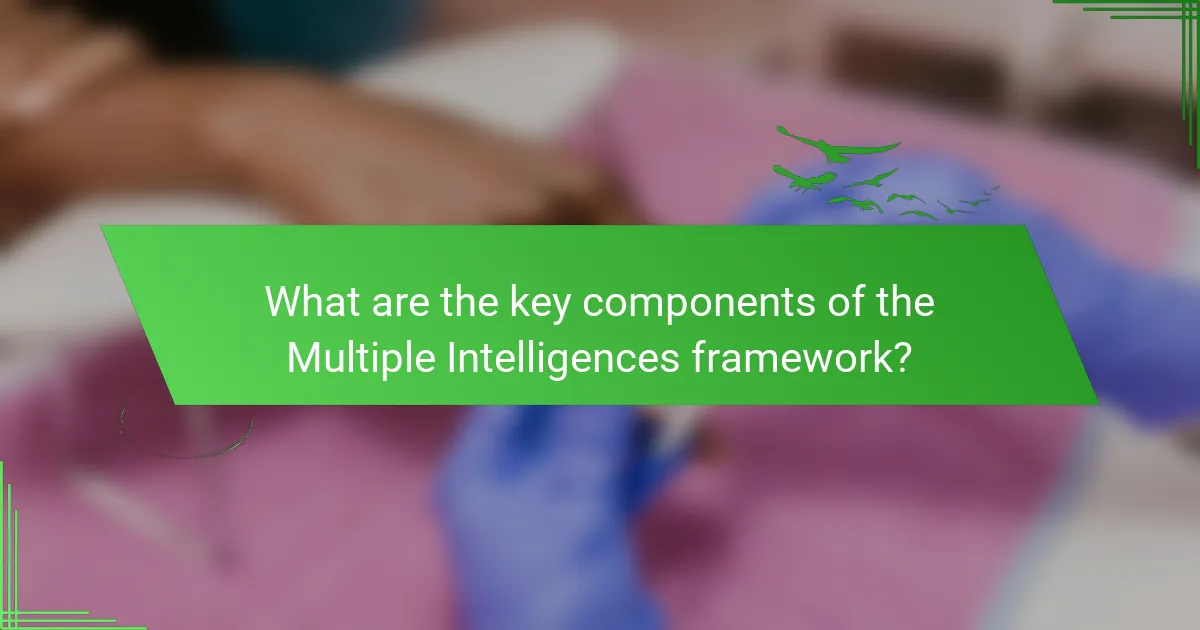
What are the key components of the Multiple Intelligences framework?
The key components of the Multiple Intelligences framework include eight distinct types of intelligence. These are linguistic, logical-mathematical, spatial, musical, bodily-kinesthetic, interpersonal, intrapersonal, and naturalistic. Each type represents a unique way individuals process information and engage with their environment. Understanding these intelligences helps tailor educational approaches to diverse learning styles.
How did Howard Gardner develop the theory of Multiple Intelligences?
Howard Gardner developed the theory of Multiple Intelligences through extensive research in cognitive psychology and education. He proposed that intelligence is not a single entity but a collection of distinct modalities. His work emphasized the importance of recognizing various intelligences, such as linguistic, logical-mathematical, and interpersonal, which can enhance educational practices. Gardner’s theory has influenced curriculum development and teaching strategies, promoting a more personalized approach to learning. This framework allows educators to cater to diverse student needs, fostering a more inclusive educational environment.
What are the eight distinct types of intelligence identified?
The eight distinct types of intelligence identified are linguistic, logical-mathematical, spatial, musical, bodily-kinesthetic, interpersonal, intrapersonal, and naturalistic. These intelligences highlight diverse cognitive strengths and learning styles. Understanding these types can enhance educational strategies and personal development. Each intelligence reflects unique attributes that contribute to an individual’s overall capabilities.
What characterizes linguistic intelligence?
Linguistic intelligence is characterized by a strong ability to use language effectively. This includes skills in reading, writing, speaking, and understanding complex language structures. Individuals with high linguistic intelligence often excel in verbal communication and enjoy activities such as storytelling, writing, and engaging in debates. They tend to have a rich vocabulary and can easily learn new languages, showcasing a unique attribute that sets them apart from others. This intelligence plays a crucial role in education, enabling effective expression and comprehension of ideas.
How does logical-mathematical intelligence manifest?
Logical-mathematical intelligence manifests through problem-solving, logical reasoning, and the ability to work with abstract concepts. Individuals with this intelligence excel in mathematical tasks, pattern recognition, and scientific thinking. They often enjoy puzzles, games, and activities that involve calculations or strategic planning. This intelligence is crucial in fields like mathematics, computer science, and engineering, where analytical skills are essential for success.
What are the traits of spatial intelligence?
Spatial intelligence is characterized by the ability to visualize and manipulate objects in space. Key traits include strong visualization skills, the capacity to understand spatial relationships, and proficiency in creating mental images. Individuals with high spatial intelligence often excel in fields such as architecture, engineering, and art, demonstrating unique attributes like enhanced problem-solving in three-dimensional contexts. Rarely, they may also possess superior abilities in navigation and map reading, making them adept at orienting themselves in unfamiliar environments.
What defines bodily-kinesthetic intelligence?
Bodily-kinesthetic intelligence is the ability to use one’s body effectively for expression, problem-solving, or creating products. This intelligence manifests in individuals who excel in physical activities, such as athletes, dancers, and surgeons. Key attributes include coordination, dexterity, and timing, which are essential for mastering complex motor skills. Educational applications of this intelligence enhance learning through hands-on experiences and physical engagement, fostering creativity and retention.
How is musical intelligence expressed?
Musical intelligence is expressed through the ability to recognize, create, and manipulate musical patterns. Individuals with this intelligence often excel in activities such as playing instruments, singing, composing music, and understanding rhythms. They can discern pitch, tone, and timbre, showcasing a deep appreciation for musical structures. This intelligence is often linked to emotional expression and cultural understanding, enabling individuals to connect with others through music.
What is interpersonal intelligence?
Interpersonal intelligence is the ability to understand and interact effectively with others. It encompasses skills such as empathy, communication, and conflict resolution, making it crucial in social and professional contexts. This intelligence allows individuals to navigate social complexities and build relationships, enhancing teamwork and collaboration.
What makes intrapersonal intelligence unique?
Intrapersonal intelligence is unique due to its focus on self-awareness and personal reflection. It enables individuals to understand their emotions, motivations, and goals, fostering personal growth and decision-making. This intelligence is foundational in developing emotional intelligence, which enhances interpersonal relationships. Unlike other intelligences, such as linguistic or logical-mathematical, intrapersonal intelligence emphasizes internal processes, making it essential for self-directed learning and personal development.
What role does naturalistic intelligence play?
Naturalistic intelligence enhances understanding of the natural world and ecological relationships. It facilitates skills in observing, categorizing, and interacting with nature, which benefits environmental awareness and conservation efforts. This intelligence supports educational applications by promoting experiential learning through outdoor activities and fostering a connection with the environment. Students with strong naturalistic intelligence often excel in subjects related to biology, ecology, and environmental science.
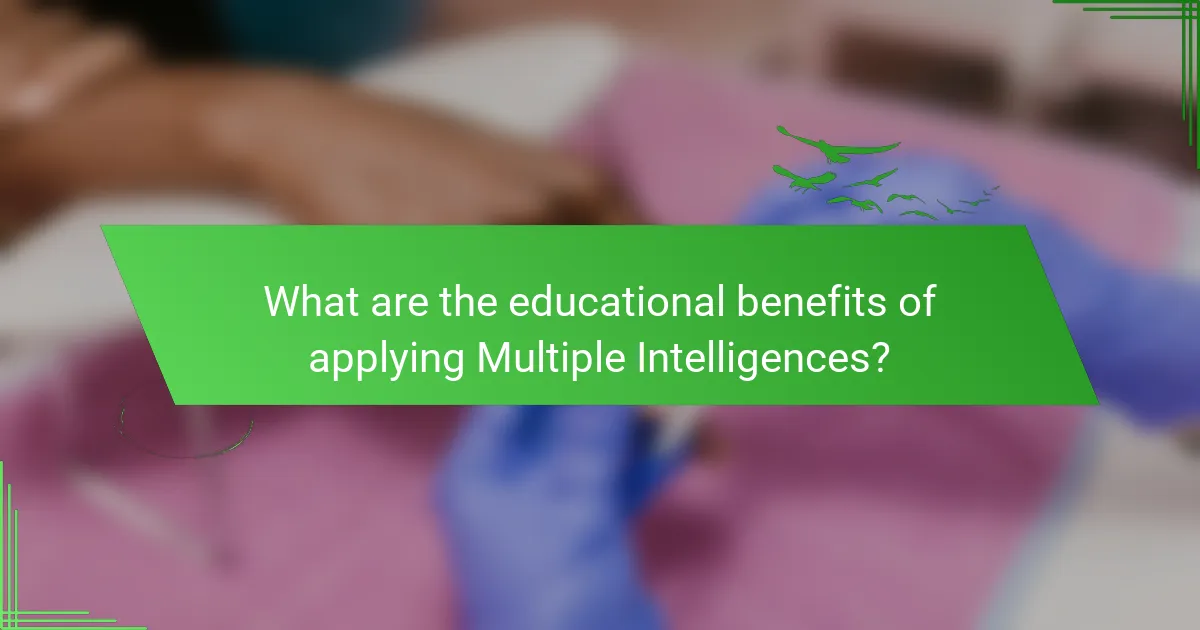
What are the educational benefits of applying Multiple Intelligences?
Applying Multiple Intelligences in education enhances personalized learning and improves student engagement. It recognizes diverse learning styles, allowing educators to tailor instruction to individual strengths. This approach fosters critical thinking and creativity, promoting a deeper understanding of material. Research indicates that students exposed to this framework demonstrate higher academic performance and motivation. Additionally, it cultivates collaboration and social skills through group activities that leverage various intelligences.
How can Multiple Intelligences enhance student engagement?
Multiple Intelligences enhance student engagement by catering to diverse learning styles. This framework allows educators to tailor instruction, making learning more relevant and effective. For example, incorporating visual aids benefits visual learners, while hands-on activities engage kinesthetic learners. As a result, students feel more motivated and connected to the material. Research shows that differentiated instruction can lead to improved academic performance and increased classroom participation.
In what ways does this framework support differentiated instruction?
The framework supports differentiated instruction by recognizing diverse learning styles and strengths. It allows educators to tailor their teaching methods to individual students, enhancing engagement and comprehension. For example, visual learners benefit from diagrams while kinesthetic learners thrive through hands-on activities. This approach fosters an inclusive environment that values each student’s unique abilities, promoting academic success across varying intelligence types.
What impact does it have on assessment methods?
Multiple intelligences significantly influence assessment methods by promoting diverse evaluation strategies. Traditional assessments often overlook different learning styles. Incorporating multiple intelligences allows educators to tailor assessments to individual strengths, enhancing engagement and understanding. For instance, a student excelling in musical intelligence may demonstrate knowledge through a song, while a kinesthetic learner might excel in a hands-on project. This approach fosters a more inclusive learning environment, accommodating various talents and promoting holistic development.
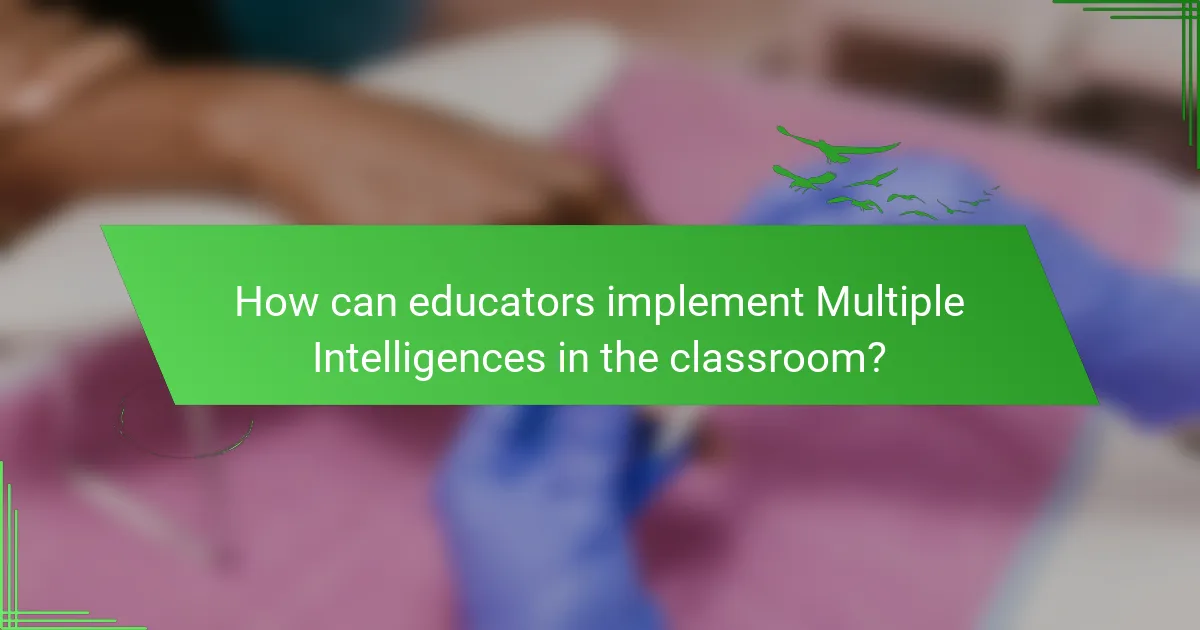
How can educators implement Multiple Intelligences in the classroom?
Educators can implement Multiple Intelligences by tailoring teaching strategies to diverse learning styles. This approach enhances engagement and retention.
1. Assess students’ intelligence profiles to identify strengths.
2. Design activities that cater to various intelligences, such as group projects for interpersonal learners or visual aids for spatial learners.
3. Incorporate technology to support different learning modalities, like interactive simulations for kinesthetic learners.
4. Foster a collaborative environment where students can share their unique skills and learn from each other.
This method promotes inclusivity and maximizes educational benefits across the classroom.
What strategies can be used to identify students’ intelligences?
To identify students’ intelligences, educators can utilize observation, assessments, and varied instructional strategies. Observing students during different activities reveals their strengths in specific intelligences. Standardized assessments can provide insights into students’ preferred learning styles. Additionally, incorporating diverse teaching methods, such as project-based learning and collaborative tasks, allows students to demonstrate their unique intelligences effectively.
How can lesson plans be designed to incorporate various intelligences?
Lesson plans can be designed to incorporate various intelligences by integrating diverse teaching methods that cater to different learning styles. For example, using visual aids supports visual-spatial intelligence, while group activities enhance interpersonal intelligence.
Incorporating music and rhythm can engage musical intelligence, while hands-on activities appeal to bodily-kinesthetic learners. Additionally, providing opportunities for self-directed projects fosters intrapersonal intelligence.
Assessing students through varied formats allows for a comprehensive understanding of their strengths. This approach not only enhances engagement but also promotes a more inclusive learning environment.
What activities promote the development of different intelligences?
Activities that promote the development of different intelligences include diverse learning experiences. Engaging in music enhances musical intelligence, while physical activities boost bodily-kinesthetic intelligence. Collaborative projects foster interpersonal intelligence, and solitary reading nurtures intrapersonal intelligence. Creative problem-solving tasks stimulate logical-mathematical intelligence, and nature exploration develops naturalistic intelligence. These activities cater to various intelligences, promoting holistic development.
How can group projects leverage diverse intelligences?
Group projects can effectively leverage diverse intelligences by allowing team members to contribute their unique strengths. This collaboration fosters creativity, problem-solving, and comprehensive understanding.
For example, interpersonal intelligence enhances teamwork, while logical-mathematical intelligence aids in data analysis. Each intelligence type enriches the project, creating a well-rounded final product.
Additionally, recognizing and valuing these intelligences promotes a sense of belonging and motivation among participants. This inclusive environment encourages individuals to share their ideas freely, leading to innovative solutions.
In summary, integrating multiple intelligences in group projects not only improves outcomes but also cultivates essential skills for future collaboration.
What role does technology play in supporting Multiple Intelligences?
Technology enhances the application of Multiple Intelligences by providing diverse tools that cater to different learning styles. Digital platforms facilitate personalized learning experiences, allowing educators to design tailored activities that engage various intelligences. For instance, interactive software can support visual-spatial learners through simulations, while audio resources benefit linguistic learners. Furthermore, technology enables collaborative learning environments, fostering interpersonal intelligence through group projects and discussions. Overall, technology acts as a bridge, connecting diverse teaching methods with the unique needs of learners, ultimately enhancing educational outcomes.
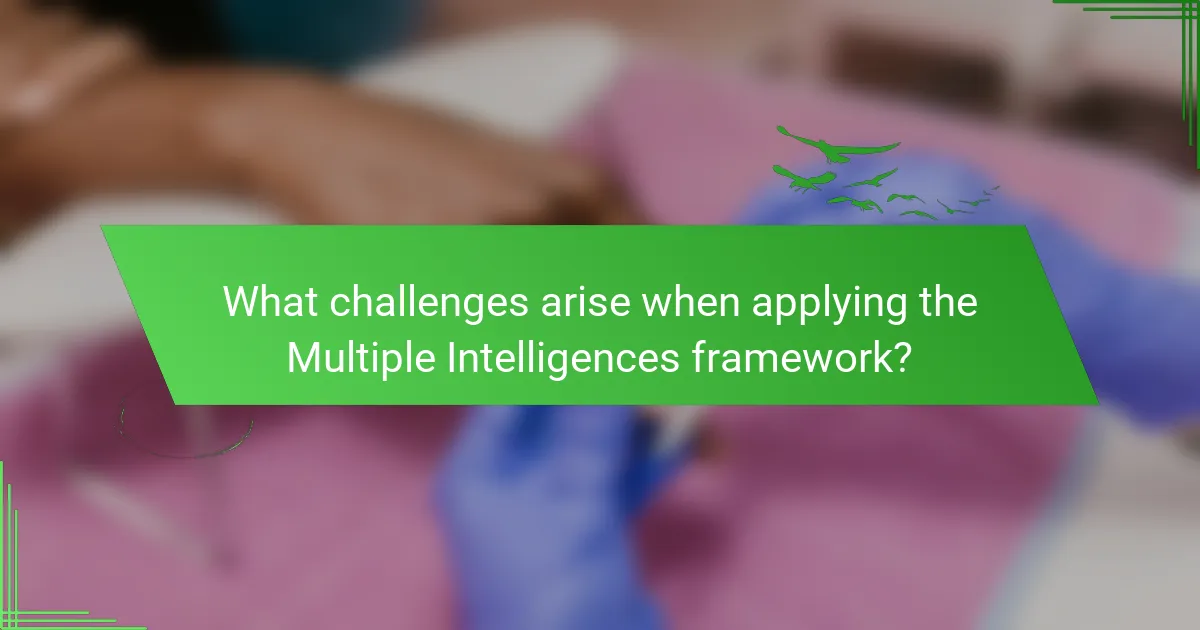
What challenges arise when applying the Multiple Intelligences framework?
Applying the Multiple Intelligences framework presents challenges such as diverse learning styles, assessment difficulties, and curriculum integration. Educators may struggle to address each intelligence effectively. Additionally, balancing resources to cater to various intelligences can be complex. Resistance to change from traditional teaching methods may hinder implementation.
What are common misconceptions about Multiple Intelligences?
Many people mistakenly believe that Multiple Intelligences imply a fixed number of intelligence types. In reality, this framework suggests that intelligence is fluid and can be developed over time. Another common misconception is that individuals possess only one type of intelligence, whereas they can exhibit strengths across multiple areas. Additionally, some think that Multiple Intelligences diminish the value of traditional IQ tests, but they actually highlight diverse capabilities that IQ tests may overlook. Lastly, there is a belief that Multiple Intelligences are exclusively applicable in educational settings, while they can also enhance personal and professional development.
How can educators address resistance to this approach?
Educators can address resistance to the Multiple Intelligences approach by providing clear evidence of its effectiveness. Engaging stakeholders through workshops can foster understanding and acceptance. Collaborating with colleagues to share successful experiences can also create a supportive environment. Additionally, tailoring the approach to meet individual student needs can demonstrate its practical benefits. Finally, ongoing professional development can help educators feel more confident in implementing this framework effectively.
What limitations exist in measuring Multiple Intelligences?
Measuring Multiple Intelligences has several limitations, primarily due to the subjective nature of intelligence assessment. Standardized tests often fail to capture the diverse ways individuals express their intelligences. Additionally, cultural biases may affect the evaluation, as traditional metrics favor certain types of intelligence over others. The unique attribute of Multiple Intelligences is that it encompasses a broad spectrum of cognitive abilities, making it difficult to quantify each type accurately. Furthermore, the lack of consensus on definitions and frameworks can lead to inconsistencies in measurement approaches.
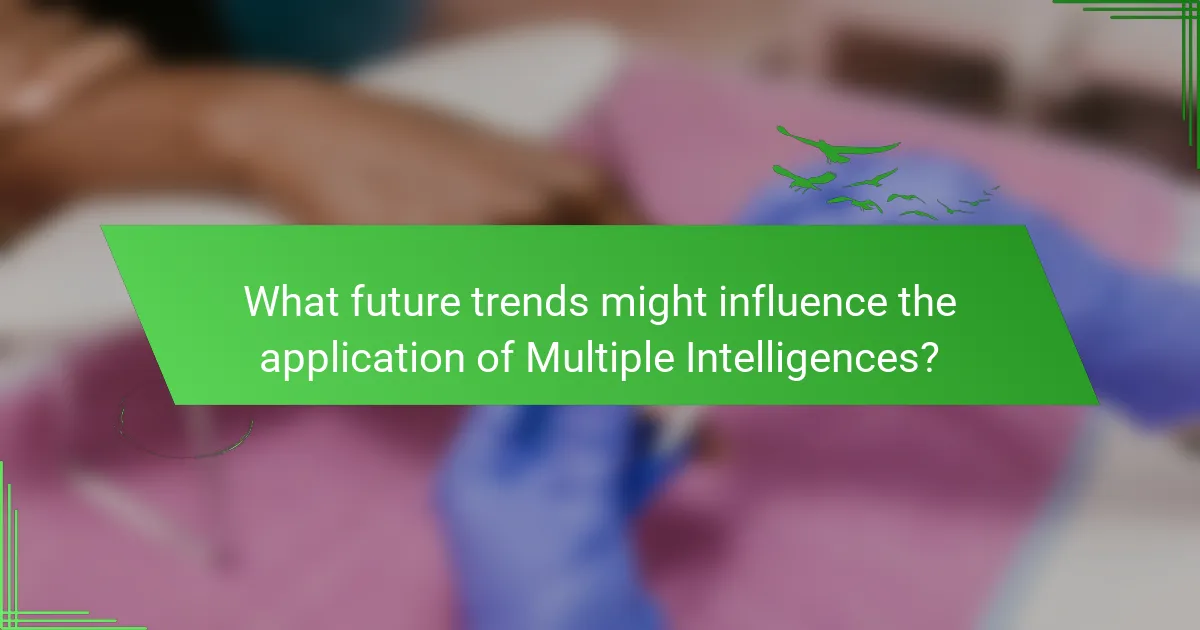
What future trends might influence the application of Multiple Intelligences?
Future trends such as technology integration, personalized learning, and diverse educational environments will significantly influence the application of Multiple Intelligences. Advancements in artificial intelligence enable tailored educational experiences that cater to individual learning styles. Furthermore, the growing emphasis on social-emotional learning promotes an understanding of interpersonal and intrapersonal intelligences. The rise of collaborative learning spaces encourages the development of various intelligences through peer interactions and project-based learning. These trends collectively enhance the effectiveness of the Multiple Intelligences framework in educational settings.
How is research evolving in the field of educational psychology?
Research in educational psychology is increasingly focusing on the application of multiple intelligences theory. This framework recognizes diverse cognitive strengths, enhancing personalized learning approaches. As a result, educators are adopting tailored instructional strategies that cater to individual learning styles. Recent studies show that integrating multiple intelligences in curriculum design can improve student engagement and academic performance. This evolution signifies a shift towards more inclusive and effective educational practices.
What role does cultural context play in Multiple Intelligences?
Cultural context significantly influences the application of Multiple Intelligences in education. It shapes how different intelligences are recognized, valued, and nurtured in various societies. For example, in some cultures, interpersonal intelligence may be prioritized, while in others, logical-mathematical intelligence is emphasized. This variation affects teaching methods and learning outcomes, as educators adapt their approaches to align with cultural norms and values. Understanding these cultural differences enhances the effectiveness of educational programs by making them more relevant and accessible to diverse student populations.
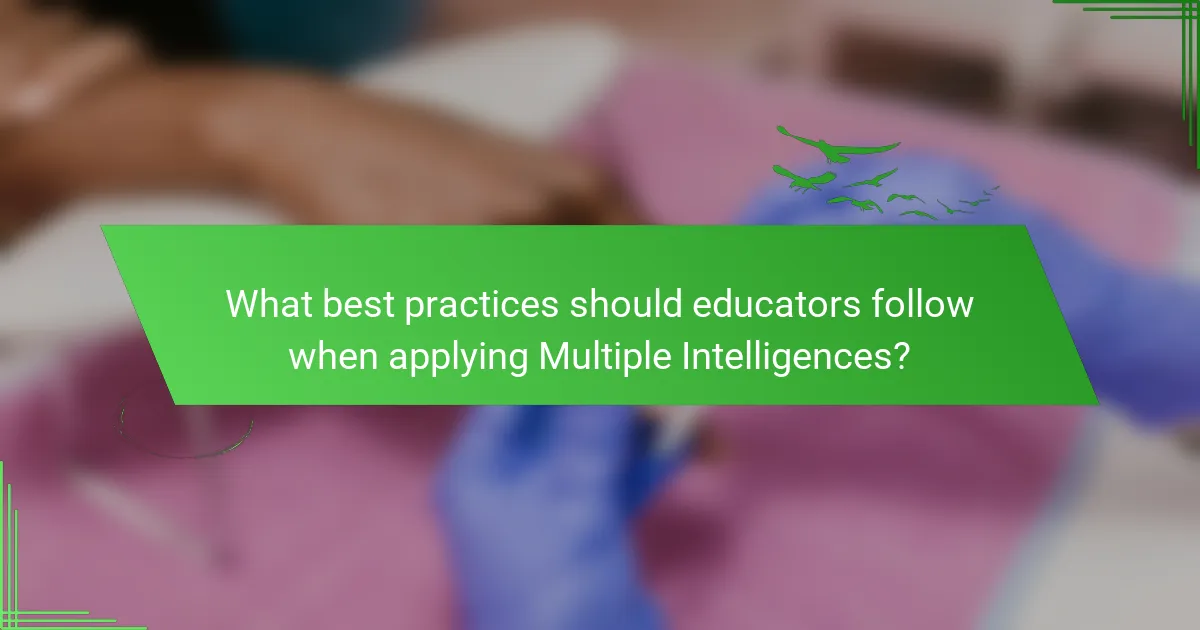
What best practices should educators follow when applying Multiple Intelligences?
Educators should apply best practices that leverage the strengths of Multiple Intelligences to enhance learning. First, assess each student’s unique intelligence profile to tailor instruction. Incorporate diverse teaching methods, such as visual aids for spatial learners and hands-on activities for kinesthetic learners. Encourage collaboration among students with different intelligences to foster a richer learning environment. Regularly evaluate and adapt strategies based on student feedback and performance, ensuring that all intelligences are engaged. This approach maximizes educational benefits and promotes holistic development.
How can teachers continuously assess and adapt their methods?
Teachers can continuously assess and adapt their methods by employing the Multiple Intelligences framework. This approach recognizes diverse learning styles, allowing educators to tailor their instruction effectively.
Regular assessments, such as quizzes and feedback sessions, help identify students’ strengths across various intelligences. For example, a visual learner may benefit from graphic organizers, while a kinesthetic learner might excel with hands-on activities.
Incorporating technology can also enhance adaptability. Digital tools provide real-time data on student progress, enabling teachers to adjust their strategies promptly.
Professional development opportunities focused on Multiple Intelligences equip teachers with innovative techniques to engage all learners. By fostering an inclusive environment, educators can maximize each student’s potential.
What are common mistakes to avoid when implementing this framework?
Common mistakes to avoid when implementing the Multiple Intelligences framework include neglecting individual learning styles, failing to provide diverse instructional strategies, and overlooking assessment methods. Additionally, not integrating the framework into the curriculum can hinder its effectiveness. Lastly, insufficient training for educators on the framework may limit its successful application.
How can collaboration among educators enhance the application of Multiple Intelligences?
Collaboration among educators enhances the application of Multiple Intelligences by fostering diverse teaching strategies. When educators share insights, they can tailor lessons to meet various intelligence types, such as linguistic or spatial. This approach promotes inclusive learning environments, allowing each student to engage according to their strengths. Collaborative planning also leads to innovative activities that stimulate critical thinking and creativity, maximizing educational benefits. As a result, students experience deeper understanding and retention of knowledge through varied instructional methods.
